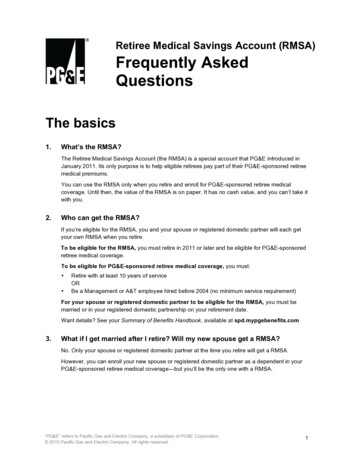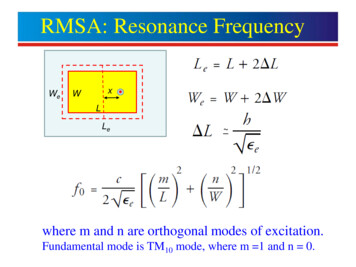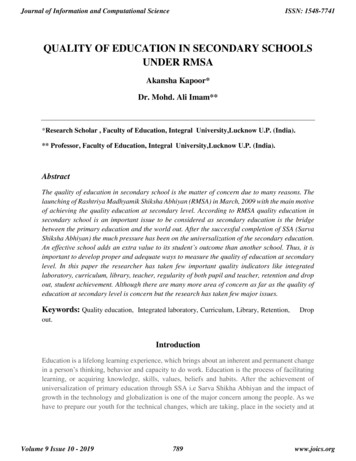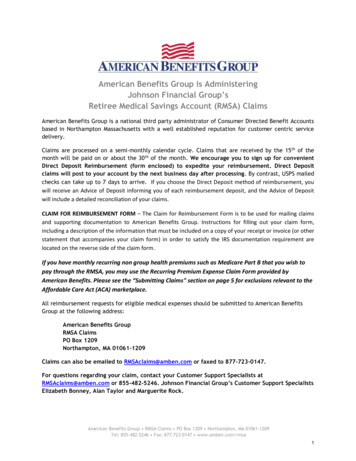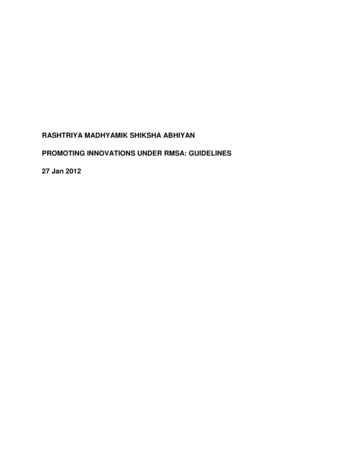
Transcription
RASHTRIYA MADHYAMIK SHIKSHA ABHIYANPROMOTING INNOVATIONS UNDER RMSA: GUIDELINES27 Jan 2012
GUIDELINES FOR INNOVATIONS UNDER RMSASeptember 23, 2011Table of ContentsBackground . 3Scope and Objective . 5Guiding Principles of Innovation. 5Eligibility . 6Institutional and Management Arrangements. 7Conflict of Interest . 10Financing Proposals . 9Documentation and Dissemination of Good Practice . 102
GUIDELINES FOR INNOVATIONS UNDER RMSASeptember 23, 2011Innovations under RMSAA.Background1. Innovation has played—and continues to play—an important role in thedevelopment of the education system in India.At the elementary level, theDistrict Primary Education Program (DPEP) had encouraged several innovativeapproaches, both in the formal and alternative sectors.In turn, much of theinnovation that took place as part of the DPEP informed and strengthened theSarva Shiksha Abhiyan (SSA) program, which encompassed these into thelarger umbrella program.2. Unlike SSA, at the secondary level, Rashtriya Madhyamik Shiksha Abhiyan(RMSA) has not had the benefit of learning from the experience of earlier Statelevel or Centrally-Sponsored Schemes of large national character like SSA, thathave promoted innovation—the trying out of new ideas to enhance the access,equity, quality and management of secondary education, especially in thedeprived parts of the country and in areas with large underprivileged populations.3. Under the current RMSA Framework, States are able to develop innovative ideasin all their activities. Nothing in these Guidelines should detract from that –indeed it is hoped that these Guidelines provide States with additional ways ofconceiving of innovations within the existing Framework. However, suchinnovation is only possible at present within the norms defining each expenditurecategory (e.g., teacher training, school up gradation, etc. It is felt that thereshould also be the option for States to be creative without the constraint of normsand for non-State agencies to be involved in designing new ideas.4. The Government of India has therefore decided to make available some fundingfor innovative activities within the RMSA Framework which would be allocatedaccording to the criteria and procedures laid out in these Guidelines.5. The Innovation component is designed in a way that would promote genuineinnovation simultaneously within the implementation framework of the RMSA.Overtime, successful innovations having significant impact on the ground and3
GUIDELINES FOR INNOVATIONS UNDER RMSASeptember 23, 2011with potential for up-scaling in wider geographies and informing larger targetgroups would be adapted and scaled up under the RMSA framework andpossibly institutionalized.6. This component would also supplement holistic implementation of RMSA. It willprovide for those interventions that do not strictly adhere to the RMSAFramework in its current approved norms and rules for different heads yet havethe potential to improve the quality of secondary education. For example, theFramework at present covers only government schools, although in some Statesgovernment-aided and private schools make up the overwhelming majority ofschools at the secondary level. Innovations could also help improve institutionalreform, scale up deserving alternative approaches piloted by non-governmentalorganizations, and encourage creative ways of enhancing capacities ofeducational functionaries. This in turn will contribute to the overall improvementin the quality of secondary education throughout the country. This componentcould also support activities which help link other Centrally Sponsored Schemesin secondary education with RMSA.7. Innovation in this context is broadly defined as an idea or an approach that aimsto bring about positive change in secondary education. Innovation could includenew “Out-of-the-Box” ideas and/or approaches that have yet to be tried out, aswell as those already tested, but on a smaller scale and in a different context. Aninnovation can also help package or aggregate existing practices in a way thathas not been tried before. It can take an existing idea, but implement it using newmethods.Finally, innovative ideas and/or approaches that “push establishedboundaries” should be encouraged.At the very early stages of initiatinginnovations the best approach to explain exactly what is meant by innovation isby example. The MHRD would disseminate brief write ups of innovative projectsalready under implementation throughout India. 1 This invaluable source of4
GUIDELINES FOR INNOVATIONS UNDER RMSASeptember 23, 2011information would be expanded gradually to include write ups of winning andeligible proposals considered deserving and innovative.B.Scope and Objective1. Innovation is envisaged as a demand-driven initiative to support the developmentof secondary education in India.It will be part of the RMSA Framework forImplementation, being governed by the same mechanism as the RMSA, locatedin MHRD.2. This innovations component will extend to government education agencies at theboth at the national and State level as well as to non-governmental organizations(NGOs), foundations, and education societies, but all proposals underinnovation shall be part of the State RMSA Annual Plan proposal and fundsshall be channelized only through the State Implementation Society forRMSA. As with other elements of RMSA, it will support activities in secondaryschools eligible for support under RMSA that aim to enhance access, equity,quality, and management at the secondary education level, in manners that areinnovative and new in approach, methodology and/or implementation strategies.3. The main rationale for the proposed component is to support initiatives that arein-line with the RMSA’s goals, but are not currently approved and/or “ready” to beincluded in the RMSA Framework in the form of national norms. This componentwould support two broad types of activities: (i) ideas and approaches that may beat an early concept stage, but show promise and are feasible to implement; and(ii) successful ideas and approaches that would have been piloted on a smallscale at the block or district level in the State or elsewhere in India and are nowready to be expanded, with potential for being replicated, scalability and impact.It is expected that lessons of experience from innovation activities will feed intothe future design of the RMSA Framework.C.Guiding Principles of InnovationIn addition to the broad principles of the overall RMSA Framework, support toinnovations will be governed by the following guiding principles:5
GUIDELINES FOR INNOVATIONS UNDER RMSASeptember 23, 20111. The innovation will support projects that can be scaled up, replicated andsustained over the longer term.2. It will encourage collaboration at all levels.3.It will be result-based with a robust M&E system.4. It will help nurture partnerships and encourage the sharing of knowledge.D.Eligibilitya)The following two categories of applicants are eligible to submit grantproposals:1. All government and semi-government agencies at the national and, Statelevel involved in education. This will include States and Union Territories andState level government education agencies such as COBSE, NCERT, NIOS,NUEPA,CISCE, CBSE, Leadership Academies, SCERTs/ SIETs/ SIEMATsSchool Boards, Mahila Samkhya groups, and vocational education centres2. Non-governmental organizations, registered as Society or Trust or Section 25Company will have to apply in partnership with national or State levelgovernment/semi-government agencies. Eligible organizations must have astrong track record of supporting education initiatives, and be in existence forlonger than 3 years.b)The following will apply to all applications:1. All proposals must focus on improving quality, access, equity and/ormanagement with special focus on teaching and learning, buildingofeducationalfunctionaries and teachers for impacting government and government-aidedschools.2. All applicants must demonstrate that proposals were prepared through aconsultative process with inputs from key stakeholders that could includeState government representatives, district level administrators, School6
GUIDELINES FOR INNOVATIONS UNDER RMSASeptember 23, 2011Management and Development Committees, Parent-Teacher Associations,community-based organizations etc.International organizations and profit-making entities are NOT eligible to applyunder the Innovations component.E.Institutional and Management Arrangements1. In keeping with the Sector wide approach adopted under RMSA, proposals forinnovative activities need not necessarily be submitted separately as an‘Innovation Proposal’.components of RMSA.They may be proposed under equity or qualitySince innovative activities happen across variousactivities and sectors, for example, ICT, Curriculum development, teachertraining, teaching methodologies, classroom behaviour, inclusive education,Continuous and Comprehensive Evaluation (CCE), child tracking, civil works,community mobilization, etc., compartmentalising the innovation component issought to be avoided.2. The RMSA institutional and management arrangements will be followed toimplement innovations. The RMSA Project Approval Board will be the approvingauthority, and the Technical Support Group will provide technical support to theRMSA Bureau in MHRD for appraisal and monitoring of such proposals/projects.However, bi-annual status reports will be provided to all stakeholders in respectof each innovation being implemented under RMSA.3. MHRD will put in place a panel of external subject experts for the purposes ofreviewing and recommending proposals (referred by TSG) for funding under thiscomponent.4. While appraising the proposal, TSG shall refer proposals to at least two subjectexperts on the panel, and the observations/recommendations of the experts shallbe part of the TSG appraisal note presented to the PAB (MHRD). The TSGwould ensure that full applications (including comments from State Departmentsof Education) are made available to each of the experts in a timely manner.7
GUIDELINES FOR INNOVATIONS UNDER RMSASeptember 23, 20115. MHRD may also invite the concerned external subject experts to take part in thePAB deliberations on these proposals. The external experts will be paidremuneration, travel and per diem as applicable.6. As and when needed, the MHRD may also secure part-time assistance/ supportfrom external subject experts on identified functional areas for developing andsupporting innovations in RMSA activities.7. The subject experts empanelled for this purpose by MHRD would have expertisein the relevant areas including Curriculum development Social Science Education Extra-curricular activities Inclusive education Vocational education Integration of life skills/work education into secondary educationEvaluation systems (including CCE, Diagnostics and Remedial EducationTeacher TrainingICT in EducationScience and Math education8. The following criteria will be used to evaluate proposals under the Innovationscomponent:(i)Innovativeness(ii)Clarity and Quality of Project Design(iii)Relevance/ alignment with State Priorities(iv)Clarity and Quality of Results Matrix(v)Feasibility(vi)Scalability & Replicability8
GUIDELINES FOR INNOVATIONS UNDER RMSA(vii)F.September 23, 2011Financial Viability and SustainabilityConflict of Interest1. In cases where an applying entity also has representation on the External subjectExperts Panel, it will not be eligible to apply for grant under the InnovationscomponentG.Financing Proposals1. As with other components of the RMSA Programme, proposals under thiscomponent will be funded as part of the overall annual allocation to the nationalagency/State Govt. under RMSA and will be subject to a limit of 5% of the totalannual allocation to the State.2. The following expenditures will not be allowed: Civil works Repair and Maintenance of buildings Any payment to faculty for attending a training program Salaries to contract faculty and staff appointed against existing teachervacanciesH.Components of the Application1. An innovation proposal will contain the following Project Description Management Plan Procurement Plan Implementation Plan/Project timeline Monitoring & Evaluation Plan Results matrix with performance indicators Indicative Budget9
GUIDELINES FOR INNOVATIONS UNDER RMSAI.September 23, 2011Documentation and Dissemination of Good Practices1. RMSA Bureau will commission analytical documentation of innovations whichcan then be disseminated widely. A communication and dissemination strategywill be developed so as to share the lessons of experience and good practice.The objectives of such a strategy would be to: Reach target beneficiaries—teachers, students and administrators—in anefficient and cost effective way Communicate clearly the components’ guidelines and procedures, especiallyas they relate to proposal submission, evaluation and selection. Share knowledge, best practices and success stories.10
GUIDELINES FOR INNOVATIONS UNDER RMSASeptember 23, 201111
The RMSA institutional and management arrangements will be followed to implement innovations. The RMSA Project Approval Board will be the approving authority, and the Technical Support Group will provide technical support to the RMSA Bureau in MHRD for appraisal and monitoring of such proposals/projects. However, bi-annual status reports will .
